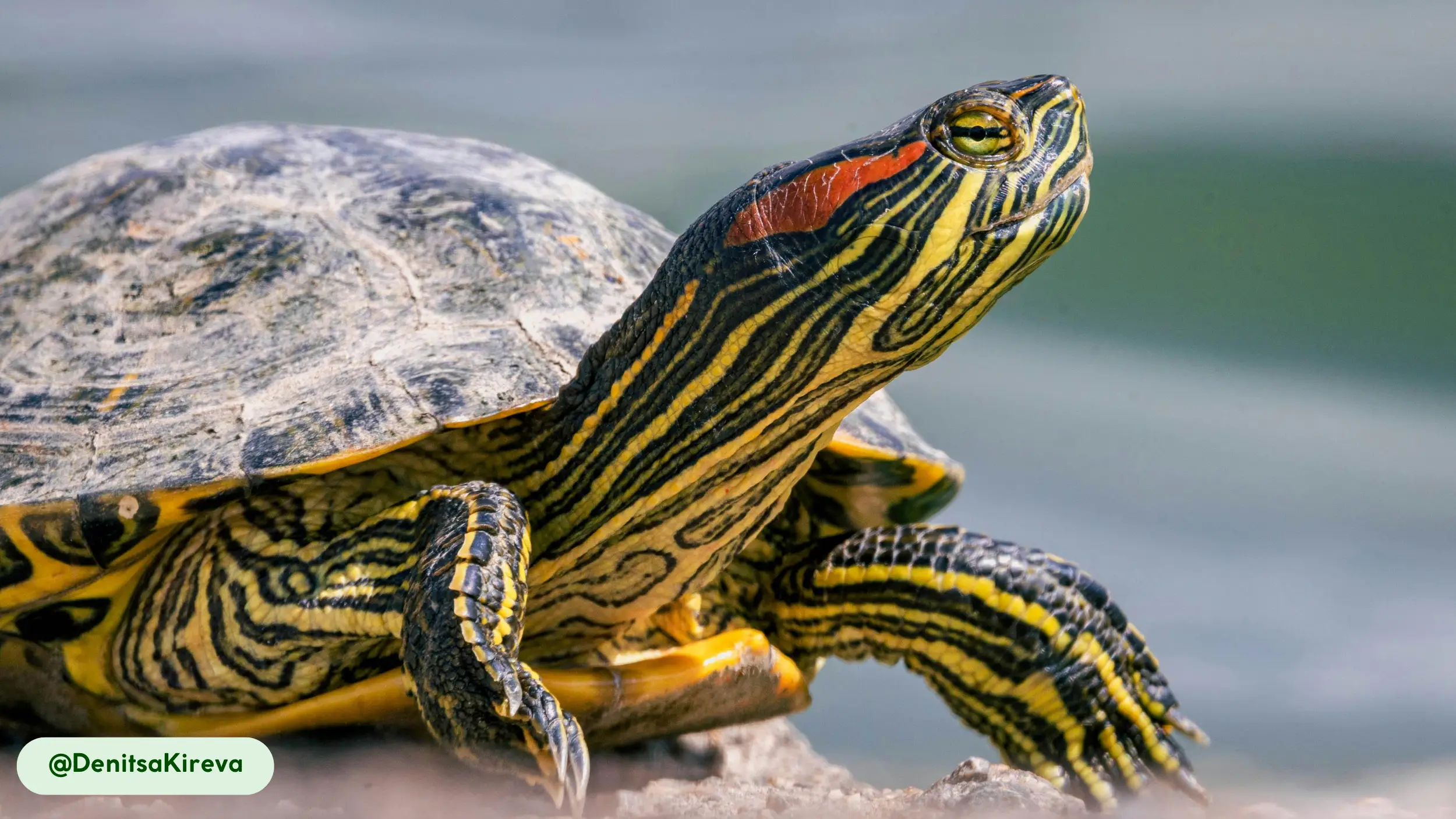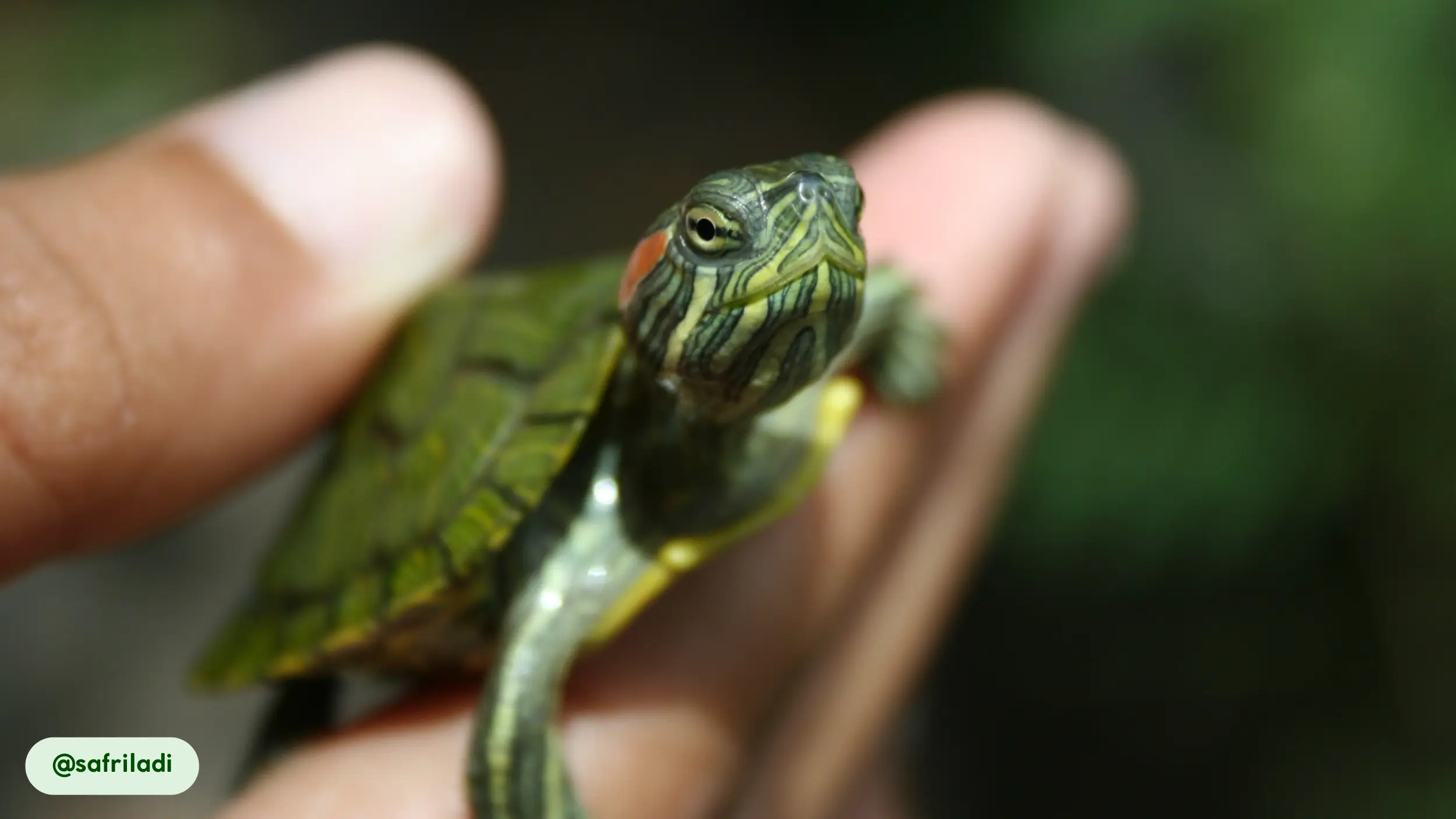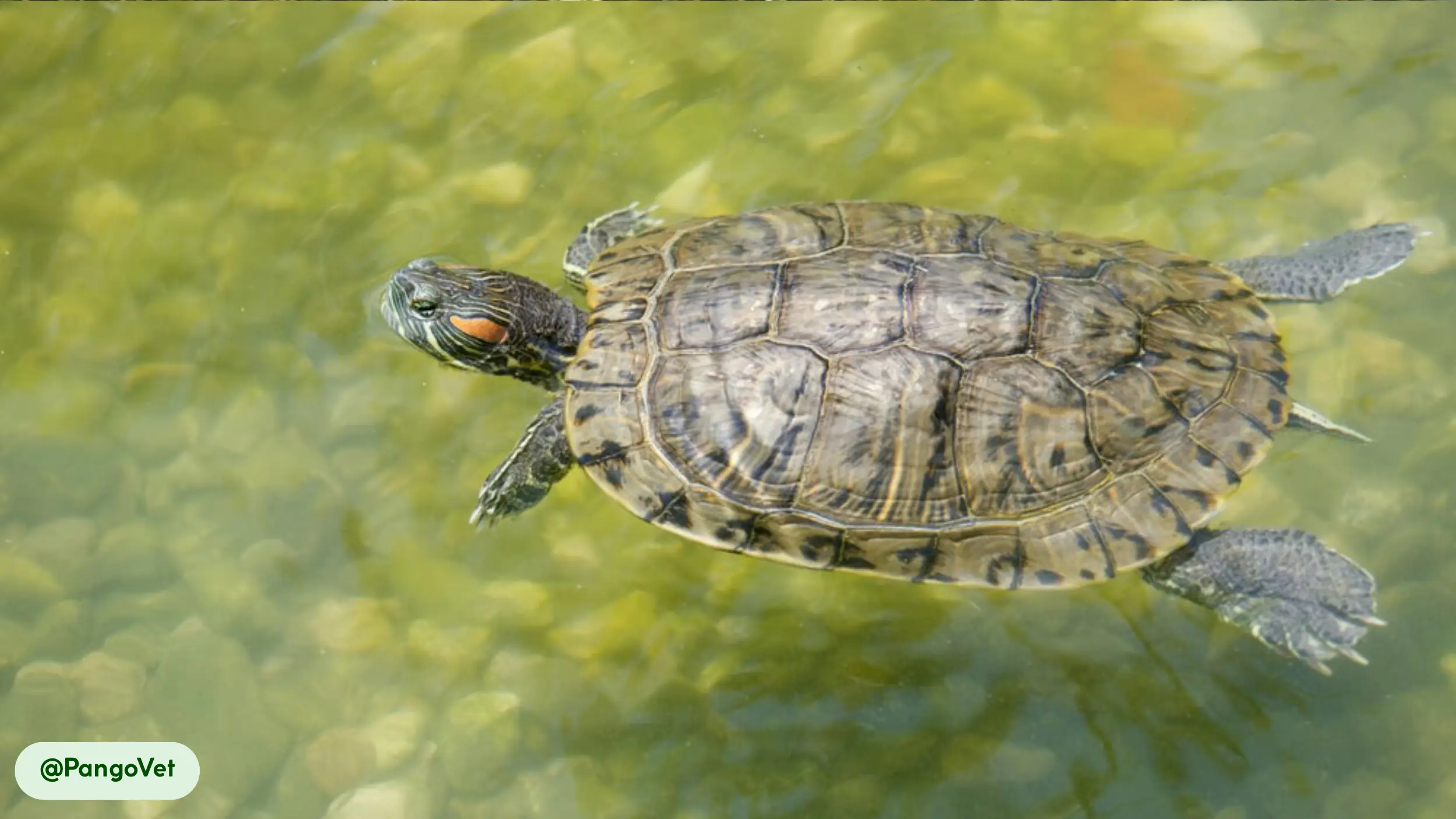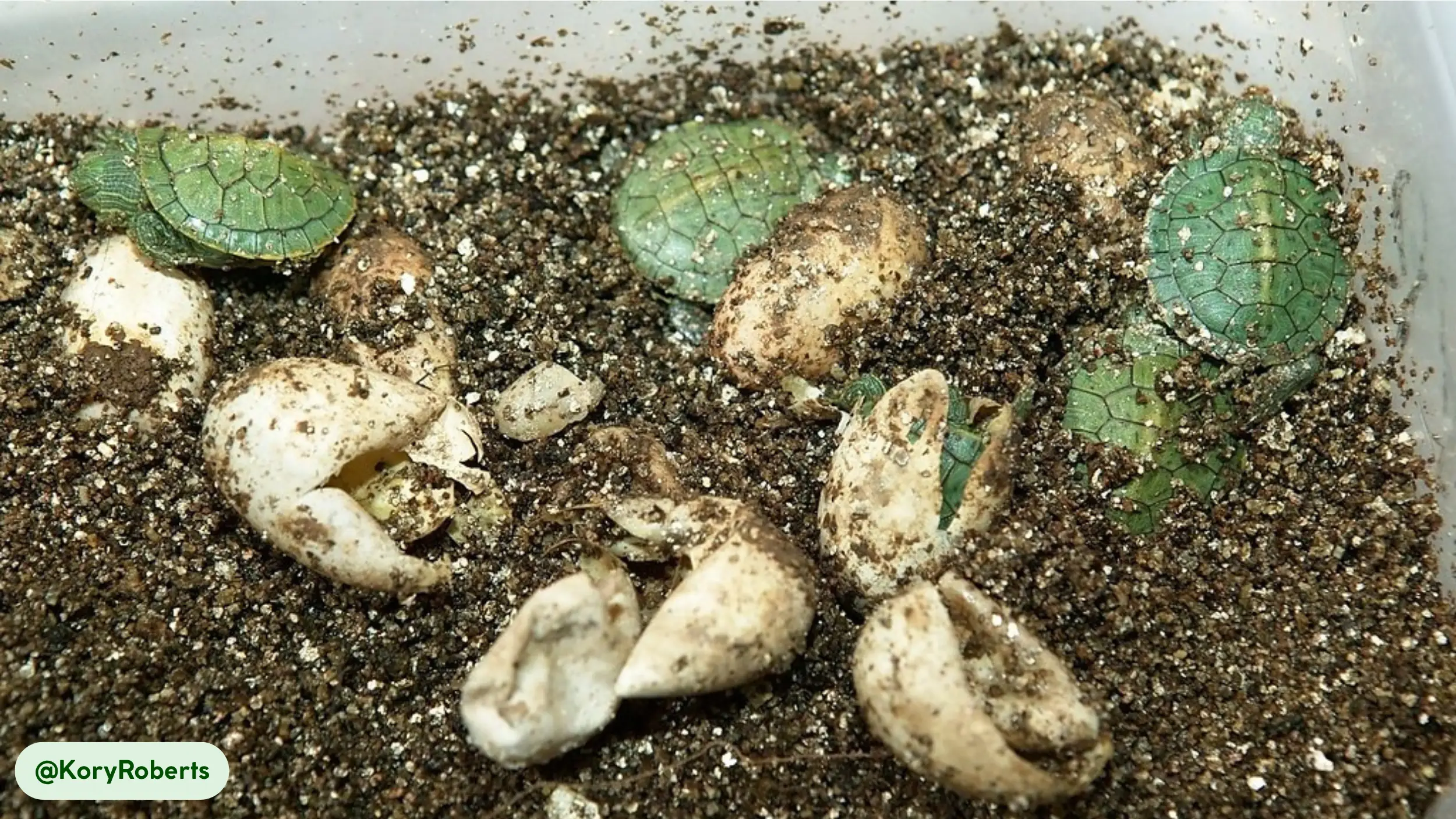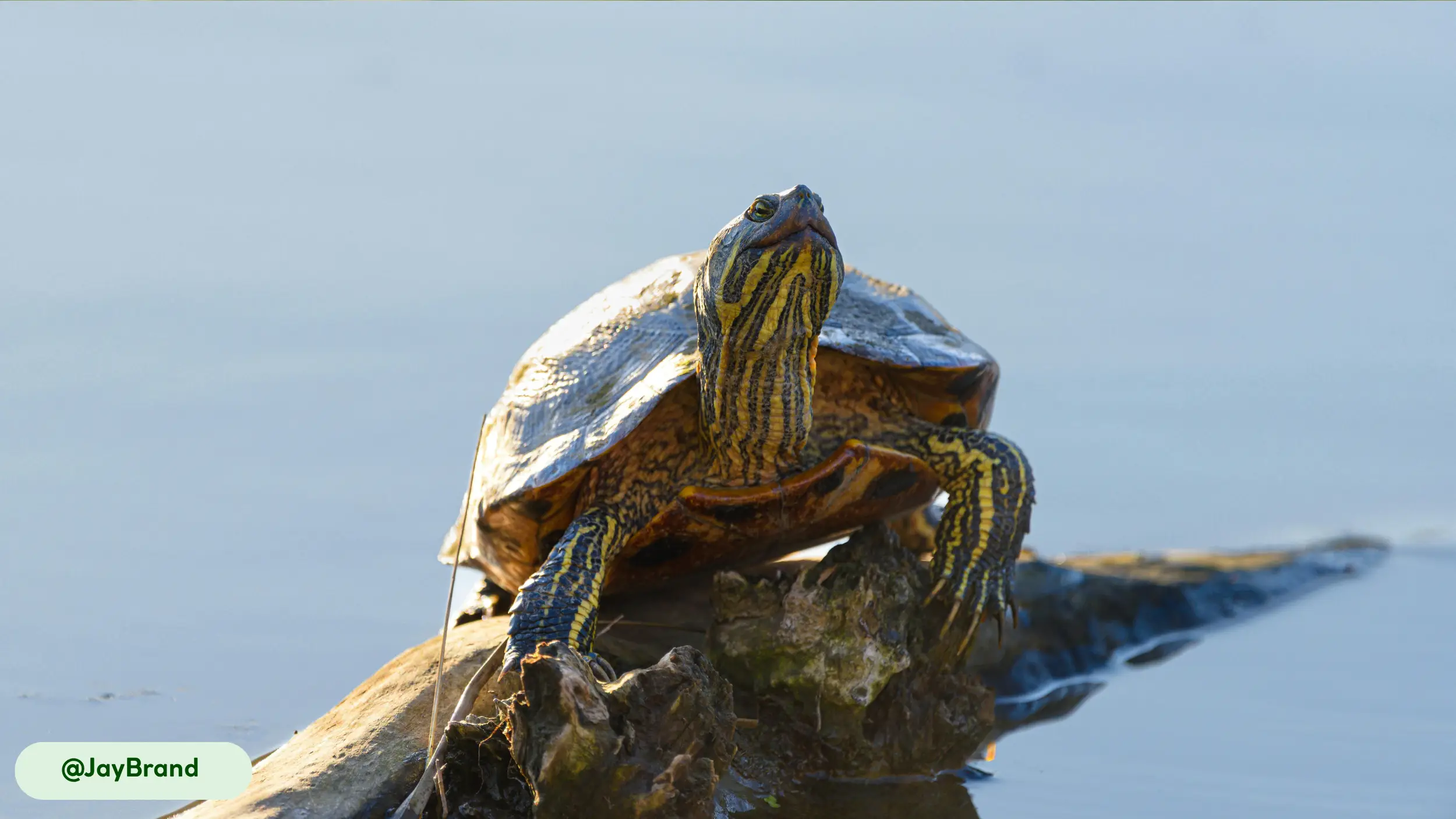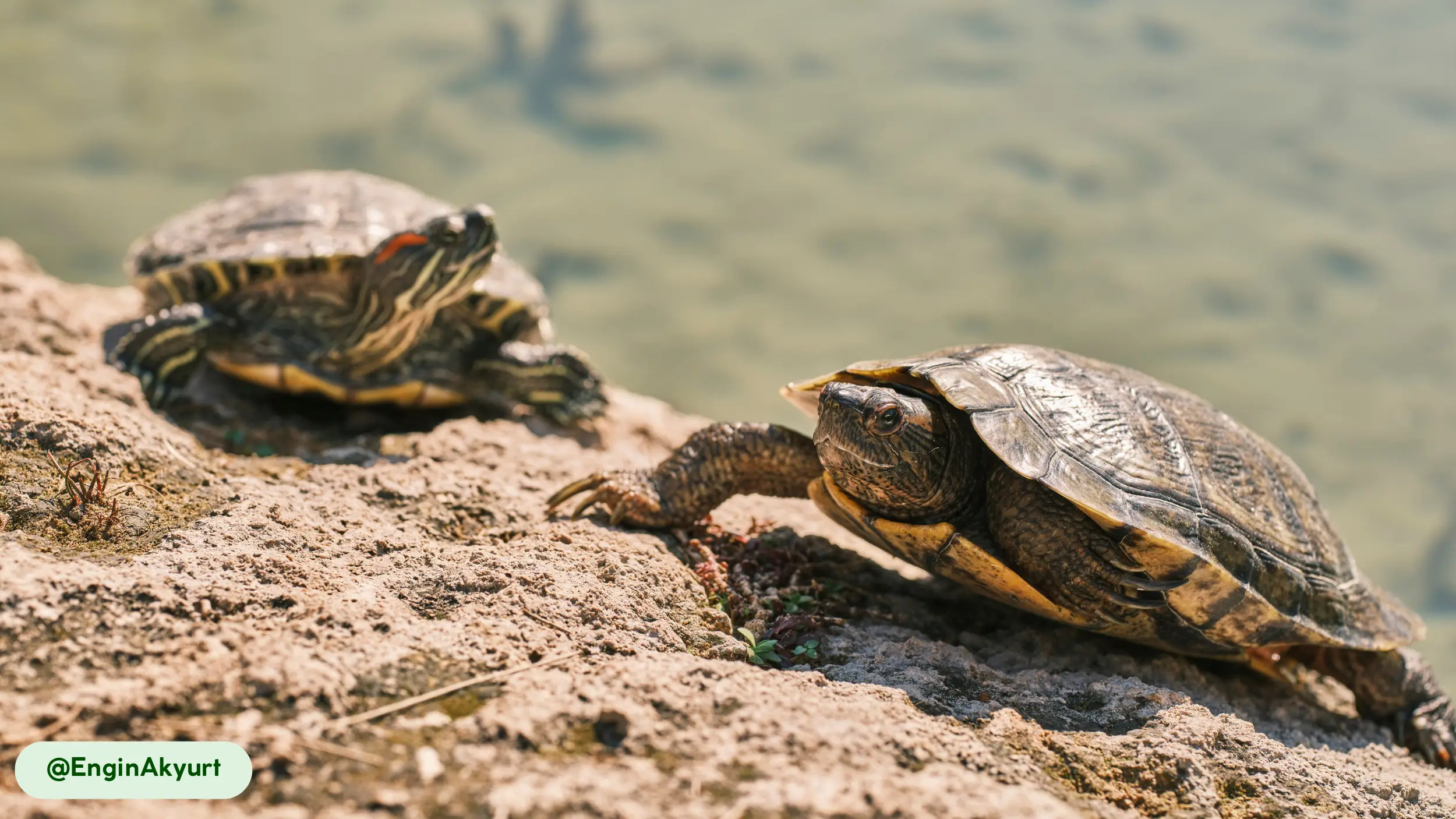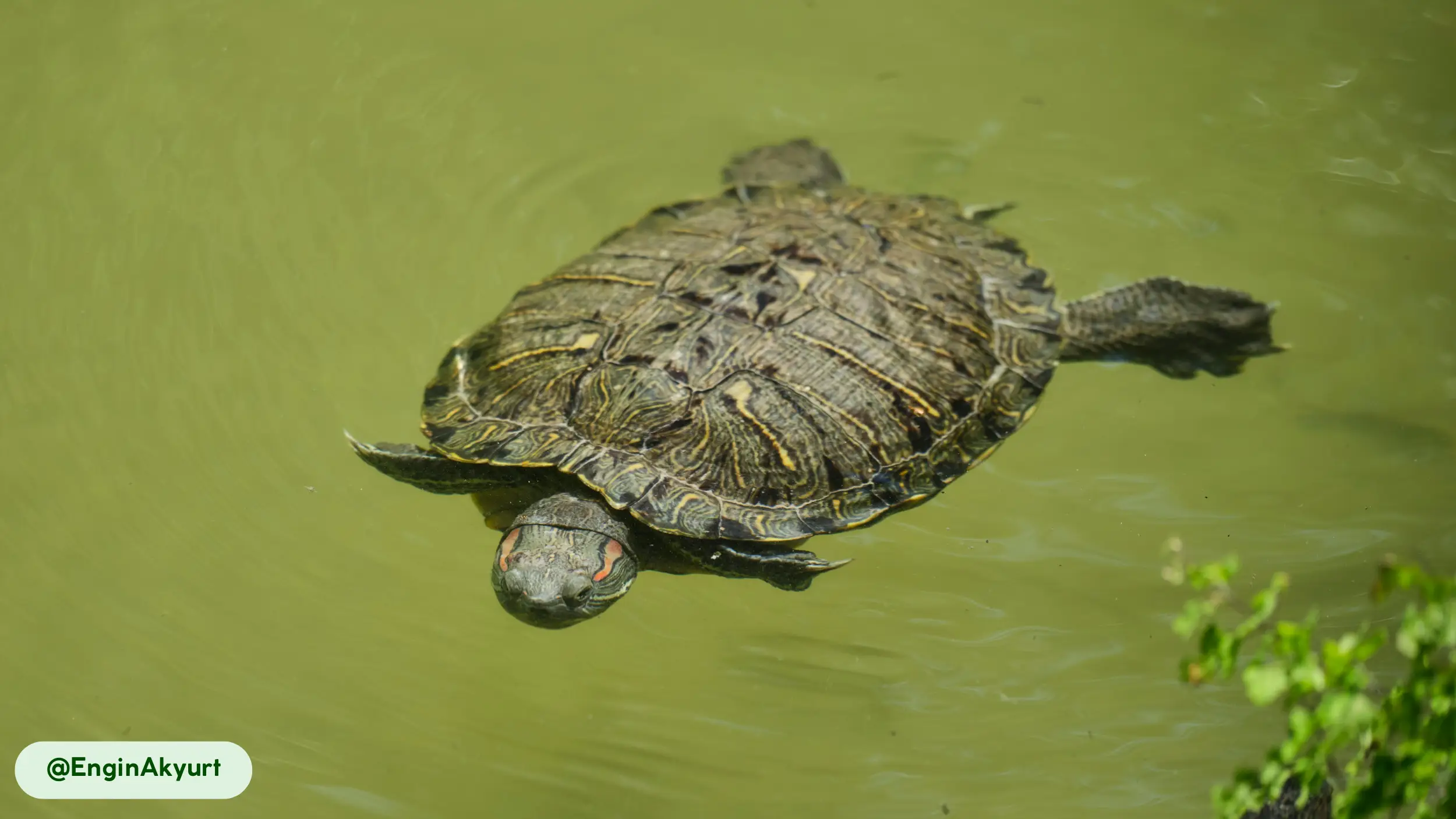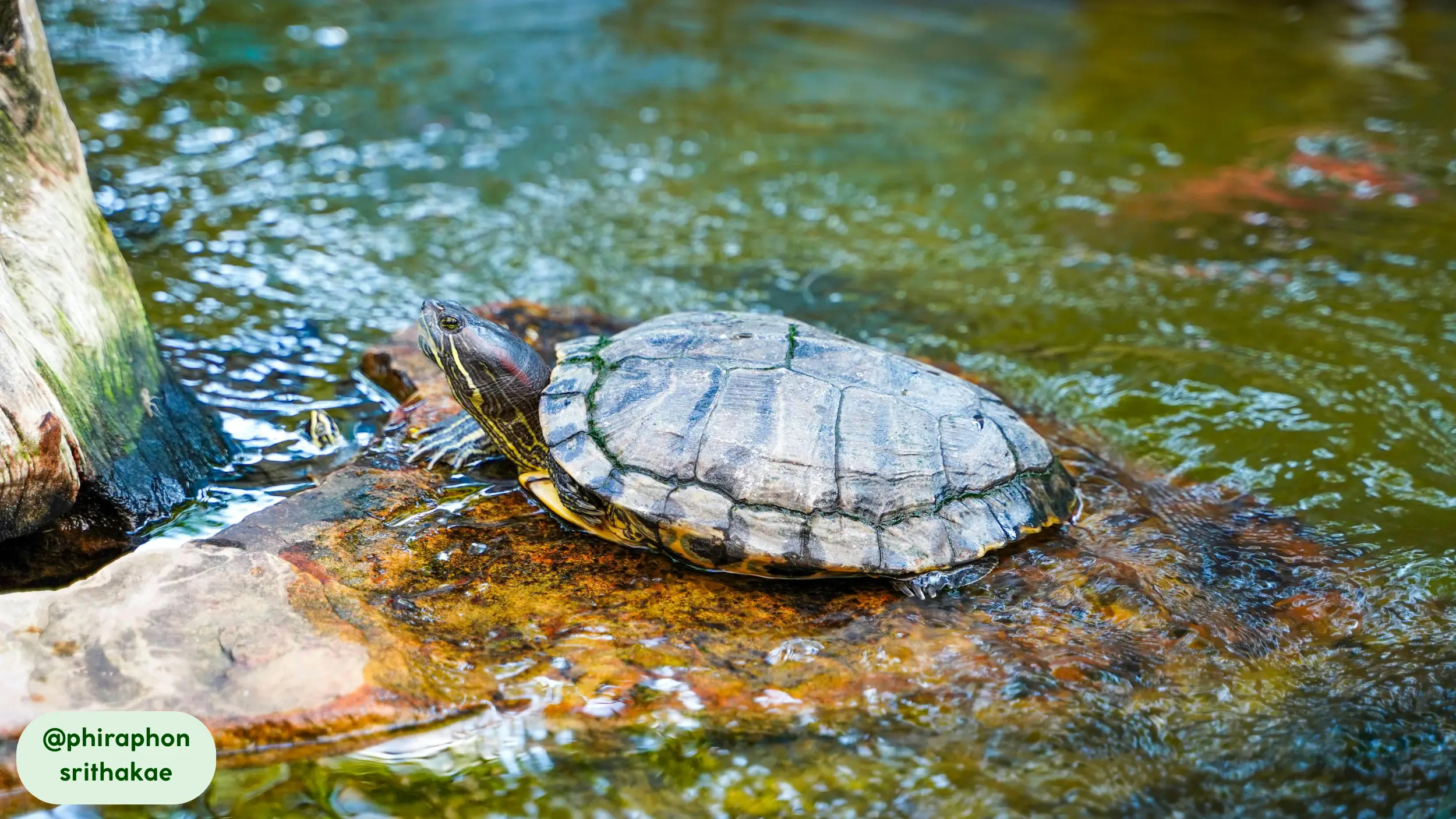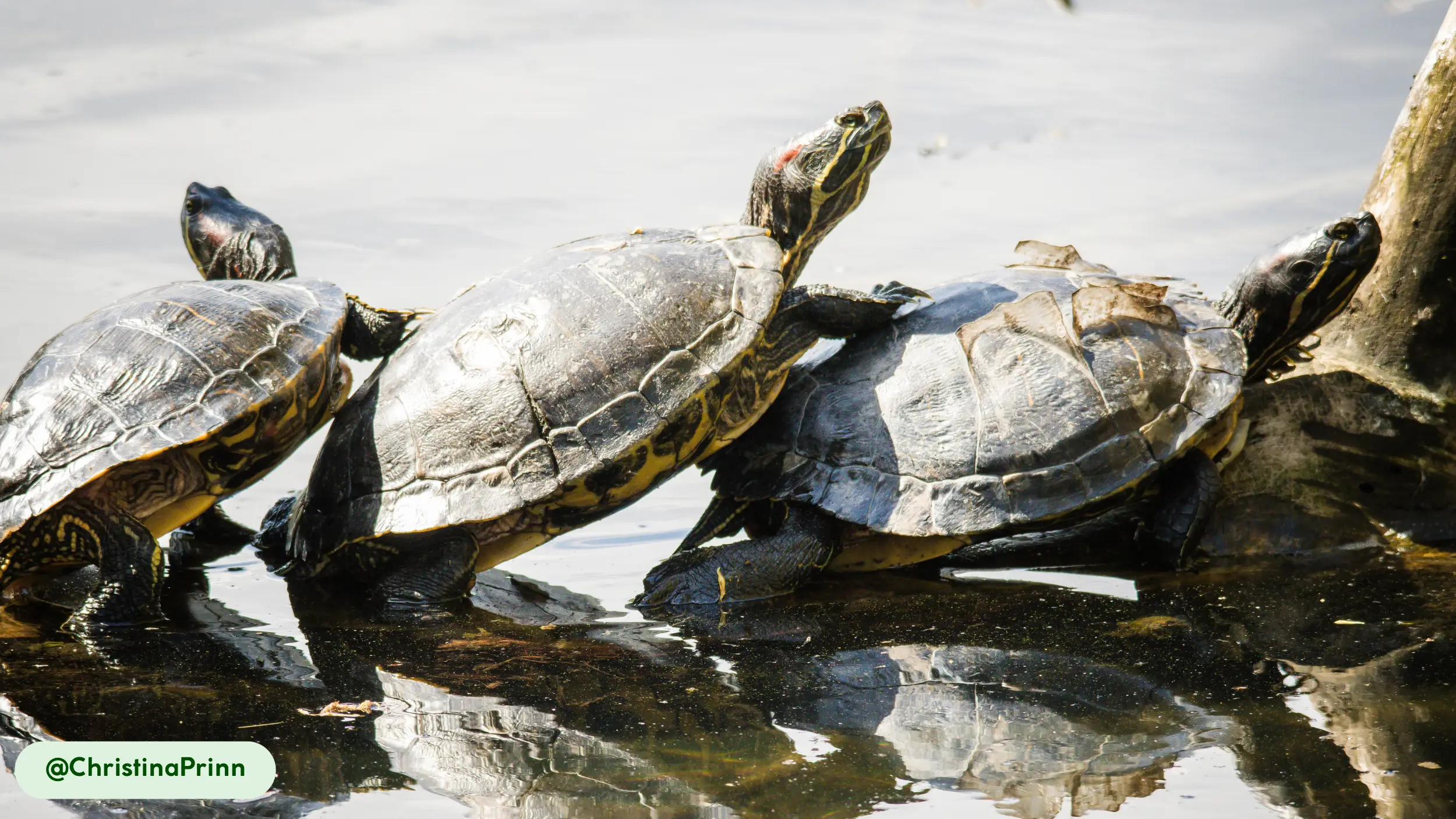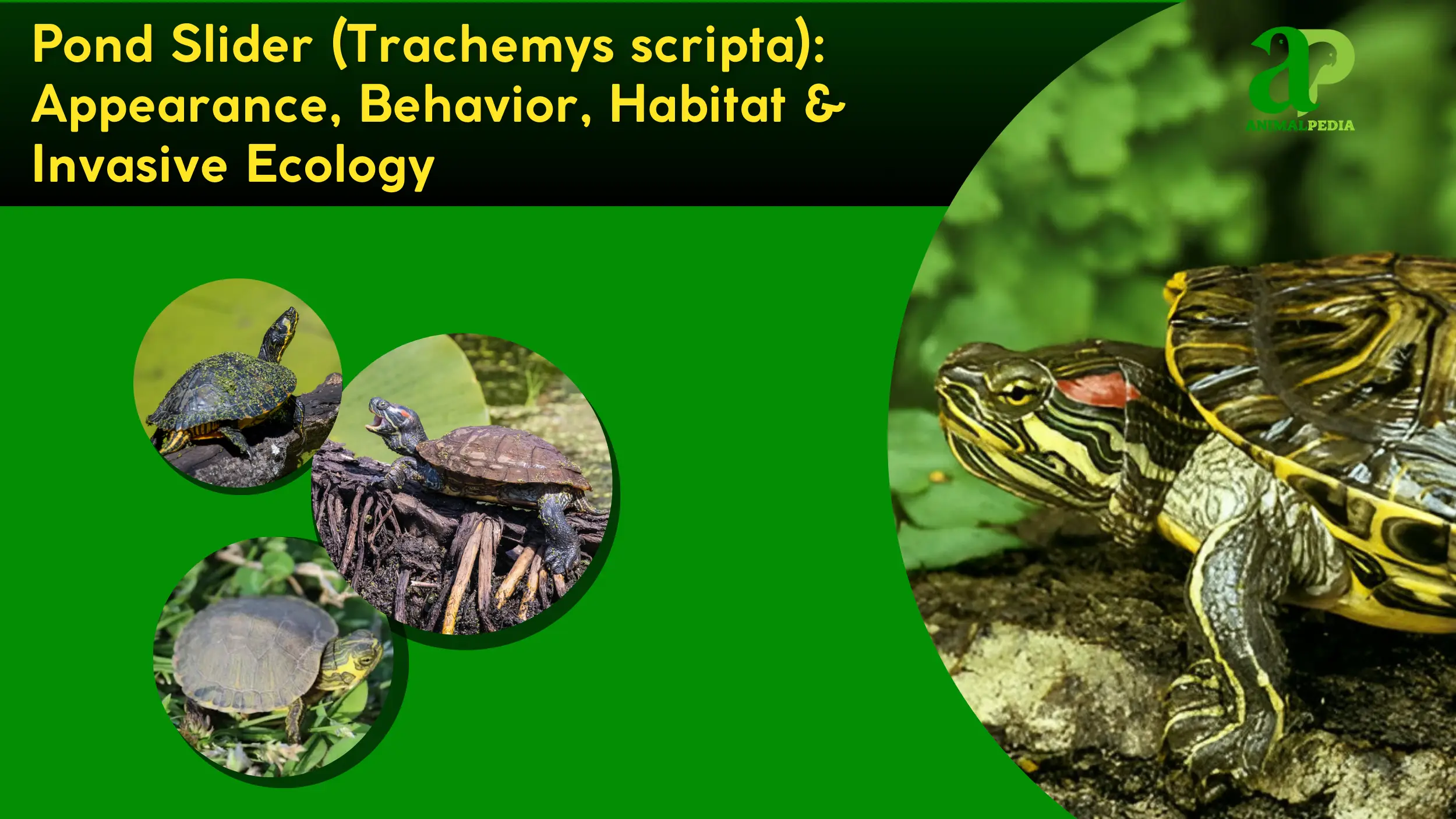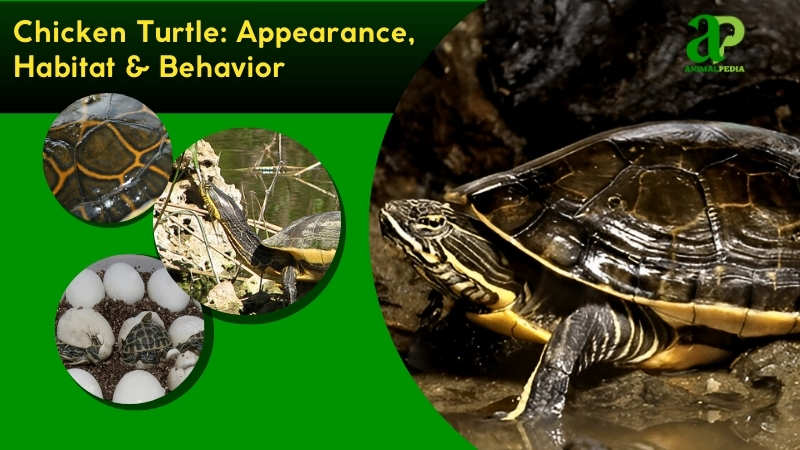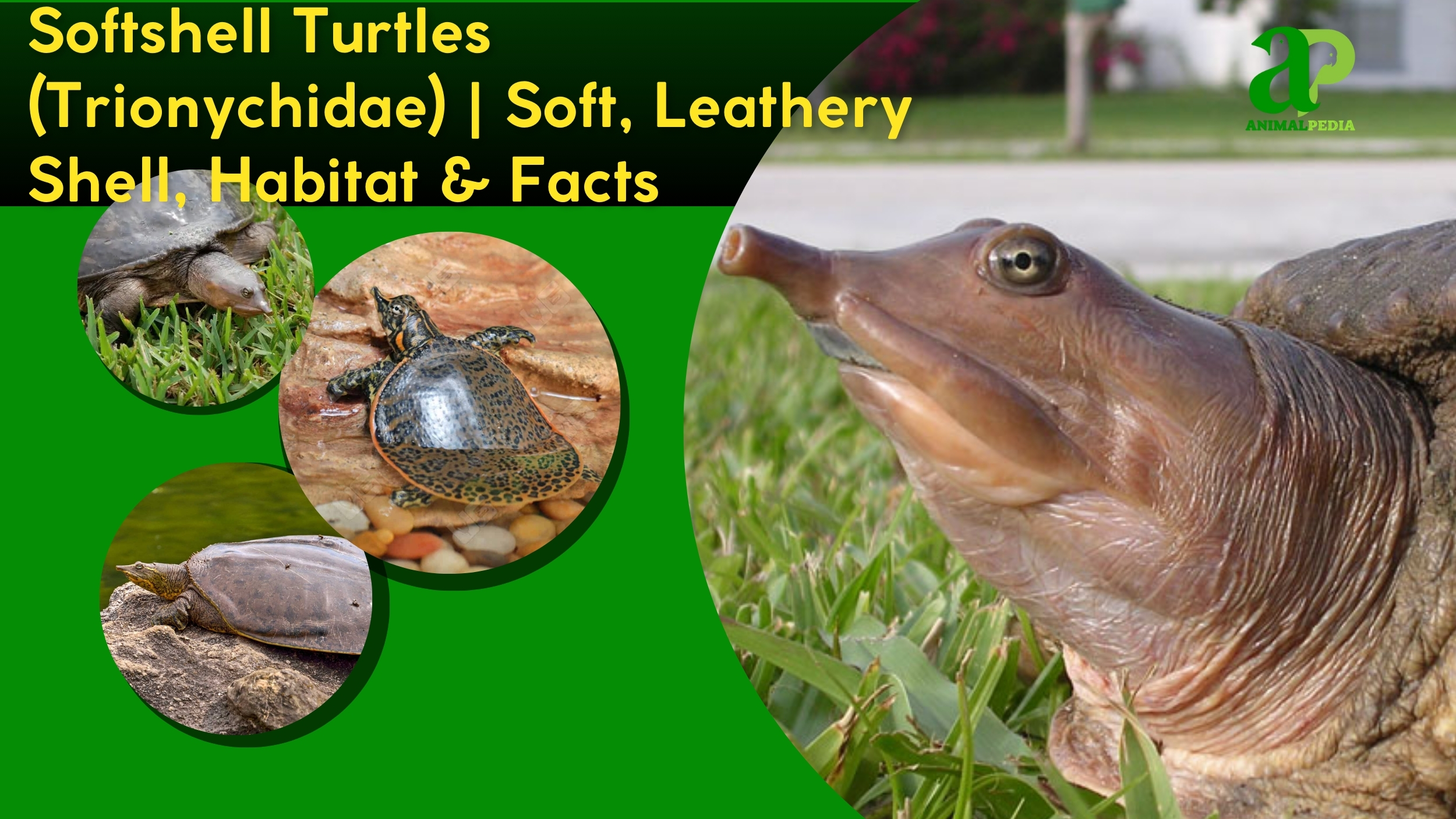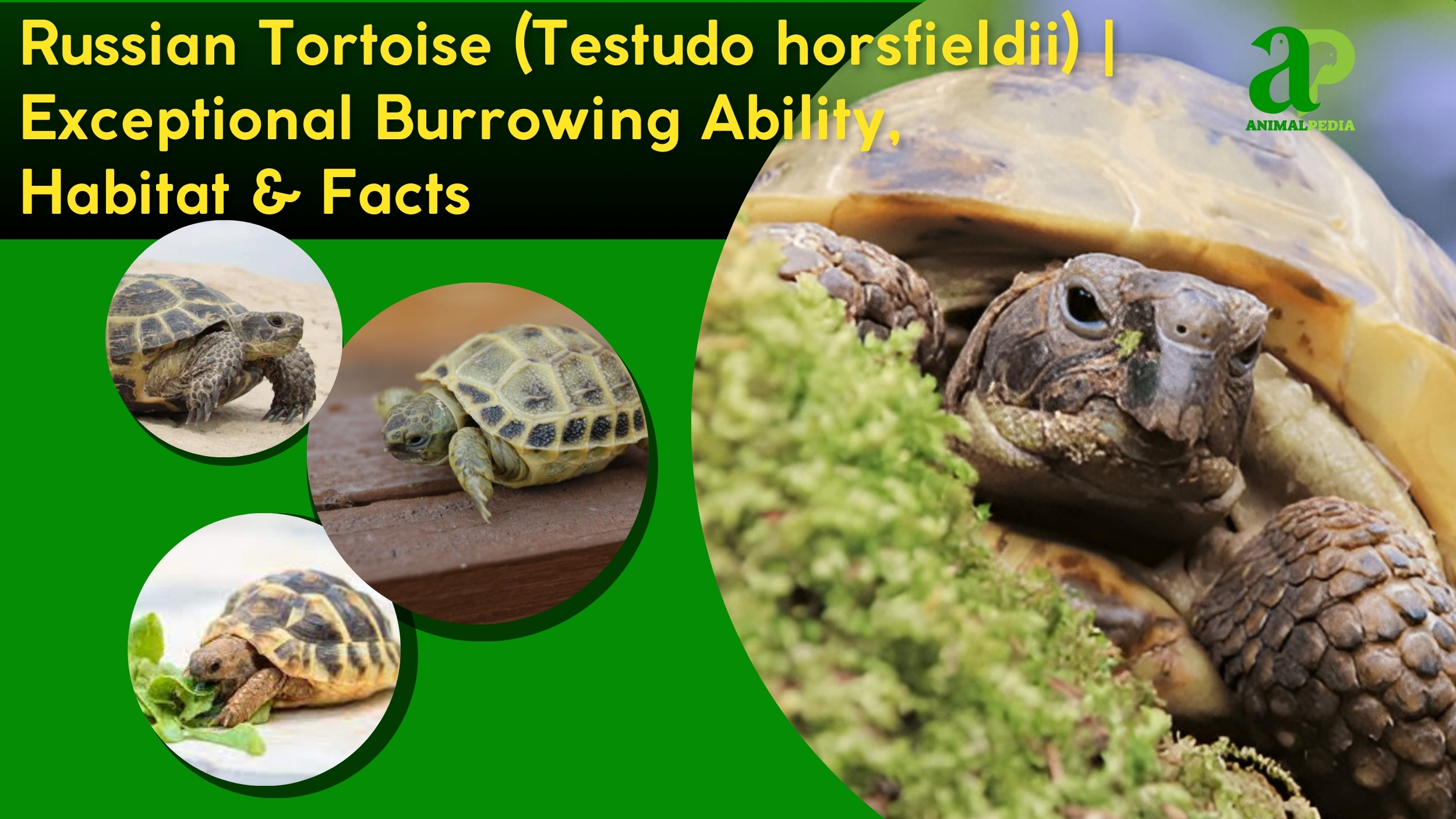Red-eared sliders (Trachemys scripta elegans) are semiaquatic turtles renowned for their distinctive red stripe behind each eye, a hallmark of this invasive species within the Emydidae family. Classified under the order Testudines, class Reptilia, these turtles average 6-8 inches (15-20 cm) in shell length, with females reaching up to 7 lbs (3.2 kg).
Native to the southern USA and northern Mexico, they have spread globally through the pet trade, thriving in freshwater habitats like ponds and rivers. Their omnivorous diet shifts from primarily animal matter (80-90%) in juveniles to 70-80% plants in adults, with opportunistic foraging behaviors. They swim at speeds up to 5-10 mph (8-16 km/h) and exhibit daily basking and seasonal brumation in cooler months. Listed as Least Concern by the IUCN, their invasive status poses ecological challenges.
This comprehensive guide will explore their physical traits, ecological roles, and human interactions, emphasizing their red ear stripe, habitat preferences, and conservation issues. From morphology to invasive impacts, it provides a detailed overview for enthusiasts and researchers.
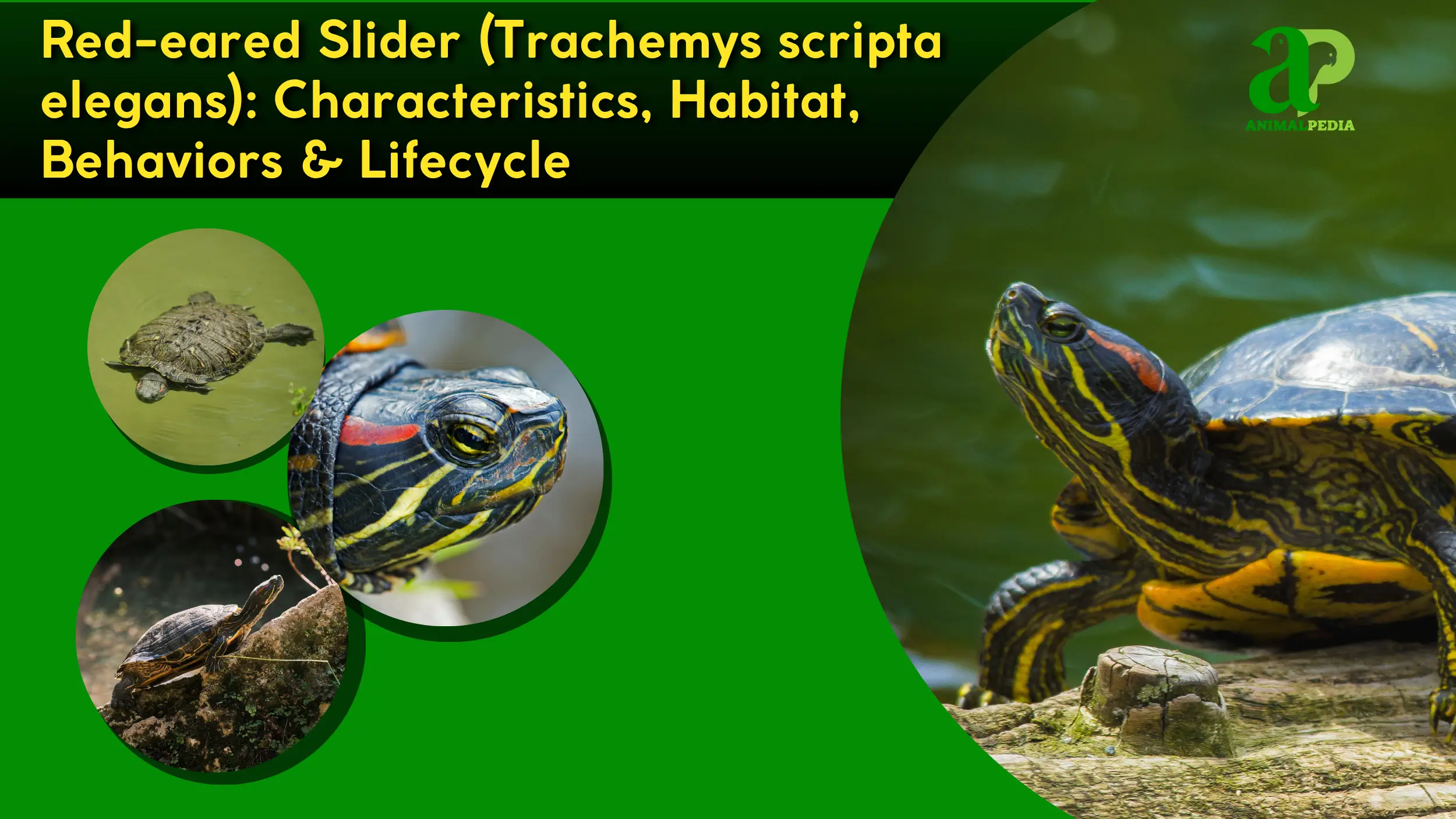
What Are Red-eared Sliders?
The red-eared slider, a widespread freshwater turtle, is identifiable by its distinctive red markings and semiaquatic lifestyle. This reptile belongs to the order Testudines, family Emydidae, and is known by the binomial scientific name Trachemys scripta elegans [1].
The species is a subspecies of the pond slider (Trachemys scripta), a group of turtles with a broad native range spanning the southern USA and northern Mexico [1]. Other common names include the red-eared terrapin and, in some regions, “tortuga de orejas rojas” [1, 7]. A 2020 study in Molecular Phylogenetics and Evolution revealed genetic admixture between red-eared sliders and related subspecies, which complicates conservation and invasion tracking efforts [13].
Some scientific debate exists regarding their ecological function, with research suggesting that they may provide beneficial services, such as nutrient cycling, in degraded urban wetlands, while other studies emphasize their detrimental impact as an invasive species that outcompetes native wildlife for food and basking areas [15, 9].
Their classification places them within a larger group of turtles with similar evolutionary histories. The scientific name, Trachemys scripta elegans, reflects key physical traits; Trachemys refers to the rough texture of the shell, scripta to its patterned markings, and elegans to the turtle’s elegant appearance [1]. This taxonomic placement situates the red-eared slider within a broad family of pond turtles, clarifying its relationship to other species within this group. Understanding the biological and physical aspects of this species is essential for comprehending its success across various environments.
Defining the red-eared slider’s place in the biological world establishes its role within the ecosystem. Understanding its core identity is the first step towards recognizing its physical form and unique characteristics.
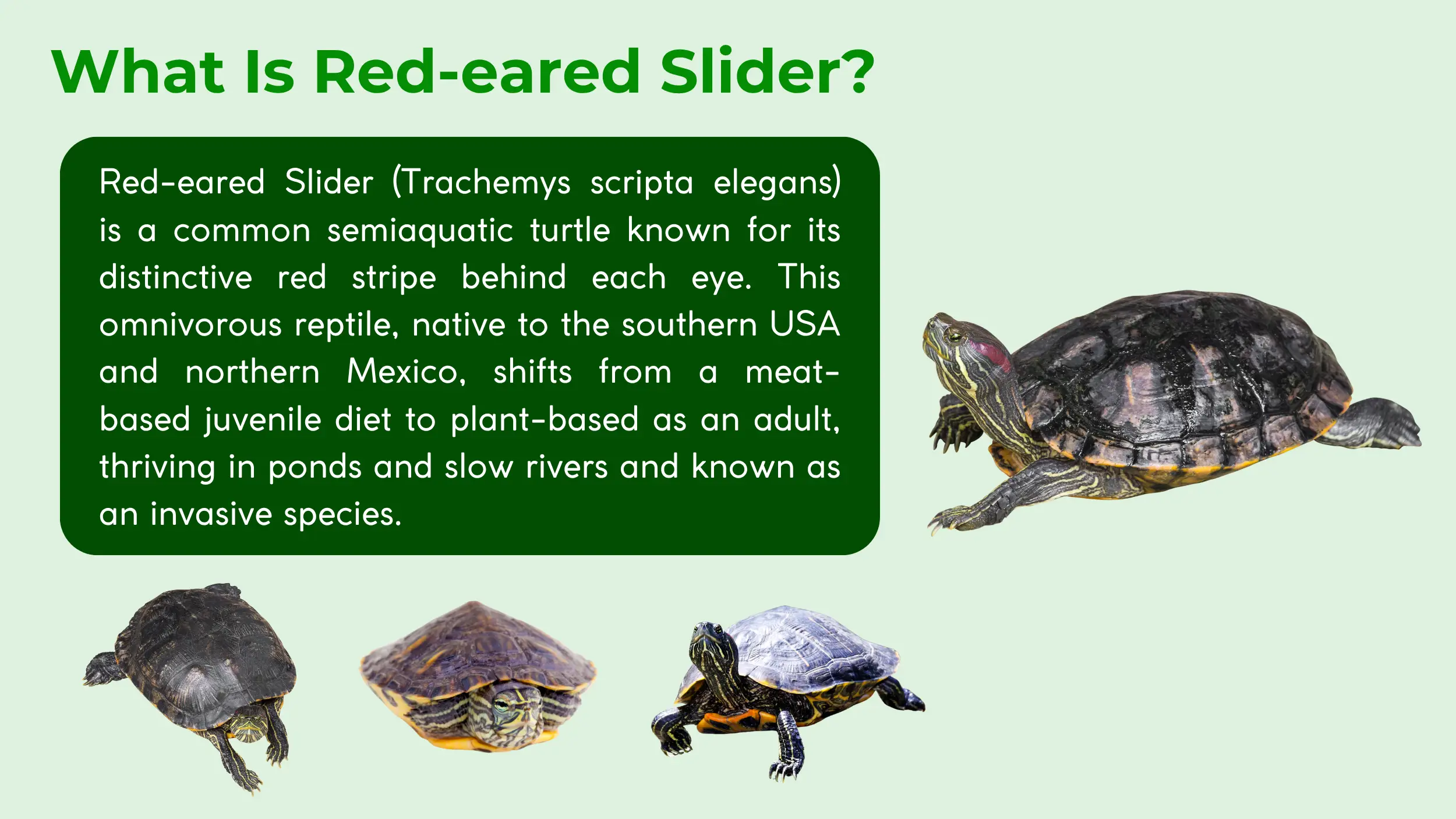
What Do Red-eared Sliders Look Like?
The red-eared slider presents a distinct physical form, characterized by a smooth, flattened plastron and an oval, rough carapace. The shell, which provides defense and protection, varies in color from greenish-yellow to gray or black, adorned with yellow lines [20]. Their dark green to brown skin has yellow stripes that run along the head, limbs, and tail [2].
They possess a sturdy, semiaquatic body with four webbed limbs, which they use for swimming and moving on land [2]. Older individuals may experience melanism, which darkens their skin and shell, reducing the brightness of their original coloration [2]. This species has a moderate tail and an upward-pointing snout.
This species has at least five key characteristics that distinguish it from others. These include their red ear stripes, their uniquely shaped head, specialized mouthparts, elongated foreclaws in males, and a defensive shell. The features provide insights into their adaptations for their habitat and behaviors. Each trait serves a specific biological purpose, from foraging to communication and defense.
- Striking Red Stripes: The most prominent feature is the small, vibrant red stripe on each side of the head, located directly behind the eye, which gives the species its name [1]. These markings are not merely for identification; they can signal the turtle’s immune health and deter predators [2].
- Webbed Limbs: The four limbs have partial webbing, which significantly improves swimming efficiency [2]. The webbed feet enable them to move through water with minimal resistance while also providing adequate support for terrestrial movement.
- Specialized Jaws: They lack teeth but have strong, horny jaw ridges for tearing and grinding their food [2]. This adaptation allows them to consume a diverse diet, ranging from small prey to tough aquatic plants.
- Distinctive Head: Their head is oblong and rounded, featuring medium-sized, dark eyes equipped with a nictitating membrane for underwater protection [2]. Small, upward-facing nostrils are positioned at the tip of their snout, allowing for efficient breathing at the water’s surface [2].
- Defensive Shell: The shell, composed of a rough carapace and a smooth plastron, provides a hard, protective covering [2]. This armor allows the turtle to retract its head and limbs for protection from predators.
Males and females exhibit sexual dimorphism in their physical characteristics. Females generally grow larger and have a flatter plastron, while males are smaller and possess a concave plastron [2]. Males also have longer foreclaws, which are used during courtship, and a thicker tail compared to females [2]. A detailed look at the species’ physical appearance reveals its adaptations. A more quantitative perspective, focusing on size and weight, provides further insight into their biology.
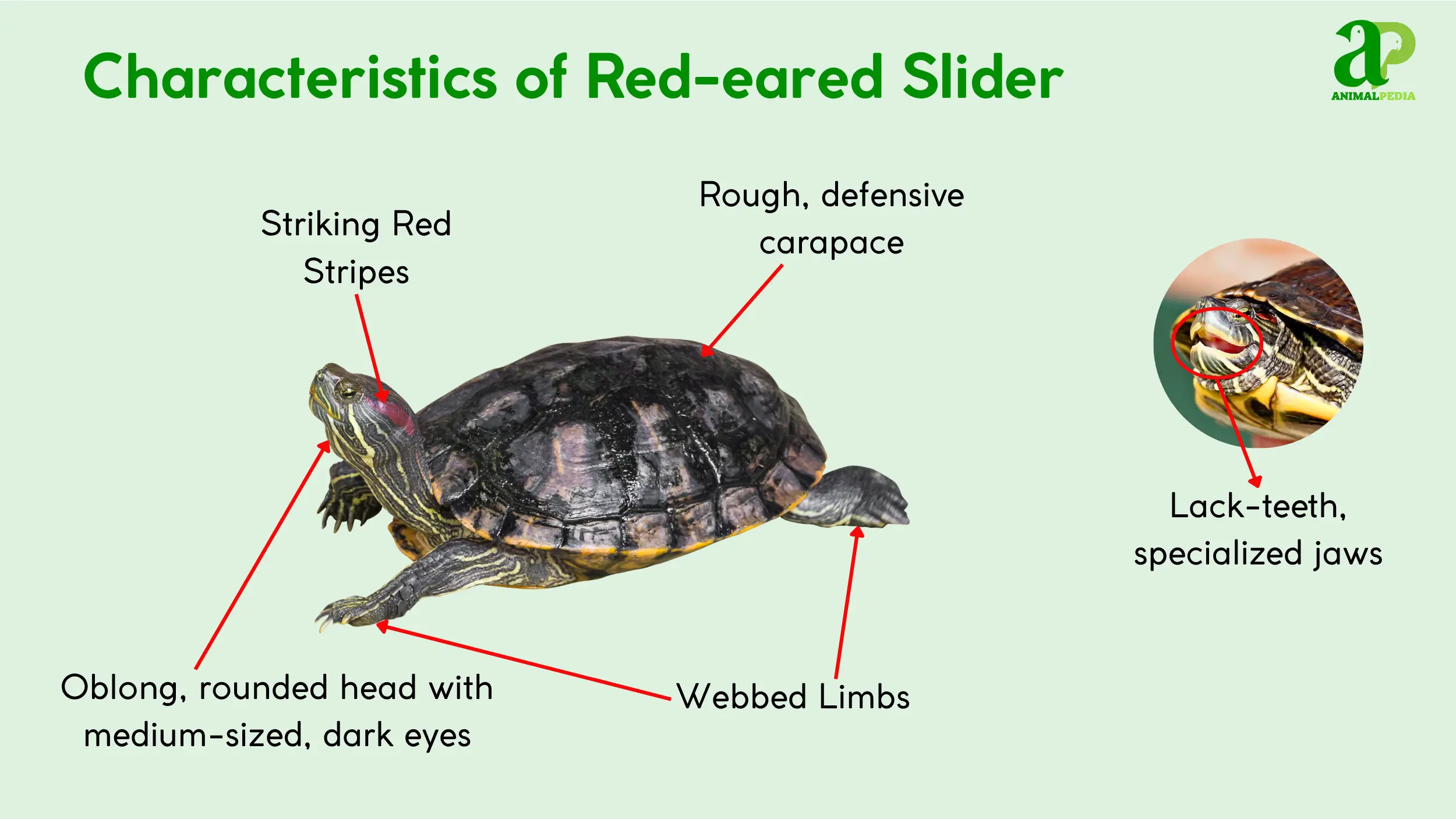
How Big Are Red-eared Sliders?
Adult red-eared sliders typically have a shell length ranging from 6 to 8 inches (15-20 cm), with some individuals reaching up to 16 inches (40 cm) in exceptional cases [2]. Female turtles can weigh up to 7 lbs (3.2 kg).
| Trait | Male | Female |
| Length | Up to 7 inches (18 cm) | Up to 11 inches (28 cm) |
| Weight | Up to 4.4 lbs (2 kg) | Up to 7 (3.2 kg) |
| Record Size | N/A | Up to 1lbs6 inches (40 cm) |
Hatchlings are quite small, measuring only 0.9 to 1.4 inches (2.3-3.5 cm) in length [2]. They mature into juveniles before reaching adulthood, with males maturing faster than females, typically between 1 and 5 years, while females take 1 to 8 years to reach maturity [2].
The size and physical build of the red-eared slider are directly related to its ability to thrive. This physical form is perfectly suited for the diverse habitats it inhabits worldwide.
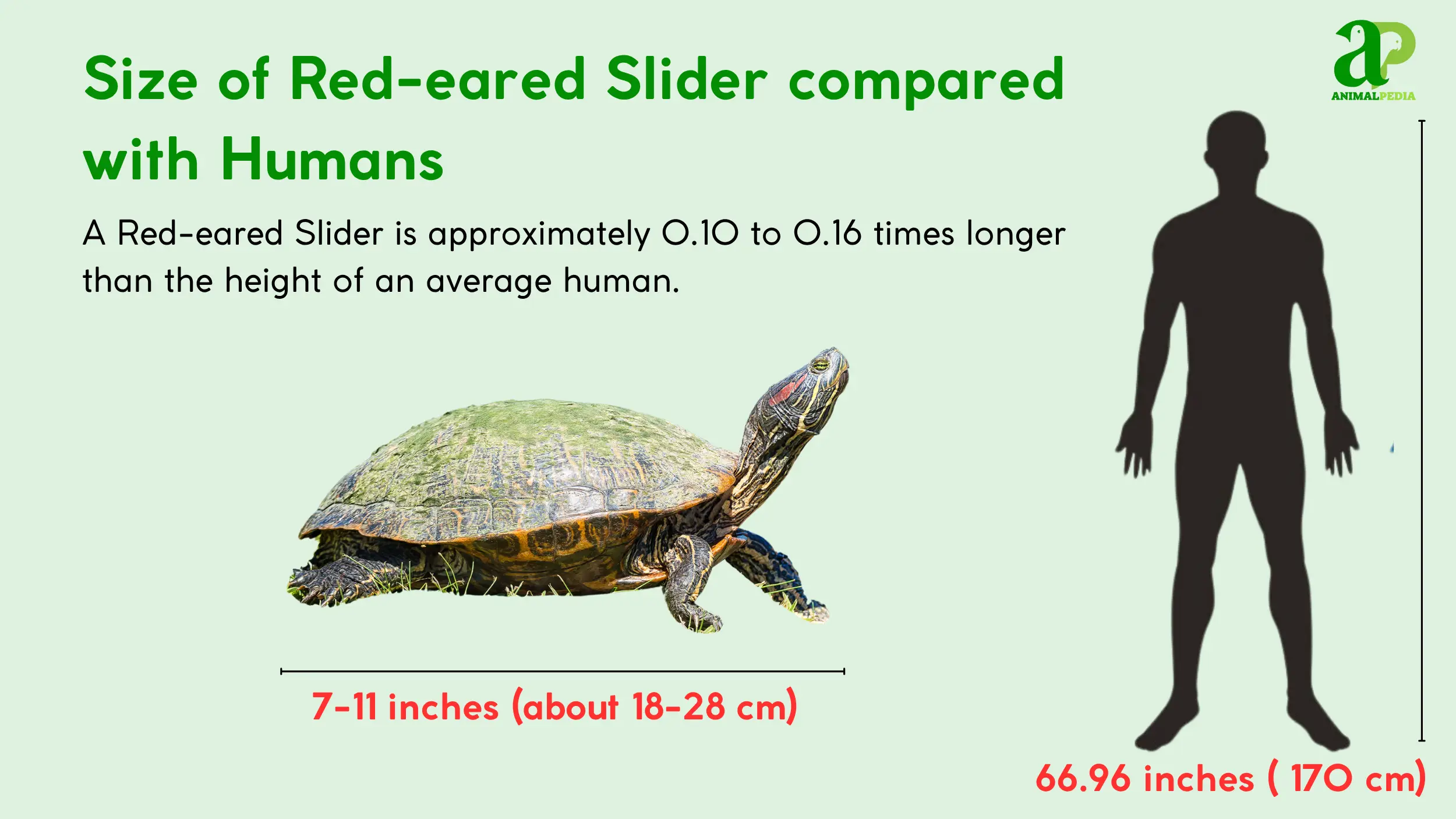
Where Do Red-eared Sliders Live?
Red-eared sliders are native to the Mississippi River basin, stretching from the Gulf of Mexico north to Illinois and west to New Mexico [1]. However, their distribution is now global, with established invasive populations across Europe, Asia, Africa, and Australia due to pet releases [7, 19].
This adaptable species thrives in calm, freshwater habitats such as ponds, lakes, marshes, and slow-moving rivers, preferring bodies of water with soft, muddy bottoms and ample vegetation for shelter and foraging [5]. They can live at elevations from sea level to 1,300 feet (400 meters) [5]. The turtles are known to tolerate a wide range of climates, demonstrating physiological resilience to cold temperatures by entering a state of brumation during the winter months [14].
While not considered highly territorial, red-eared sliders have social hierarchies. They often aggregate in large numbers to bask, but individuals may exhibit aggressive behaviors to compete for favorable basking locations [4]. These locations, which are often logs or rocks, are crucial for thermoregulation and the synthesis of vitamin D [4].
The environment an animal inhabits shapes its behaviors and daily routines. From a quiet pond to a busy river, a red-eared slider’s actions are driven by its need to survive and reproduce.
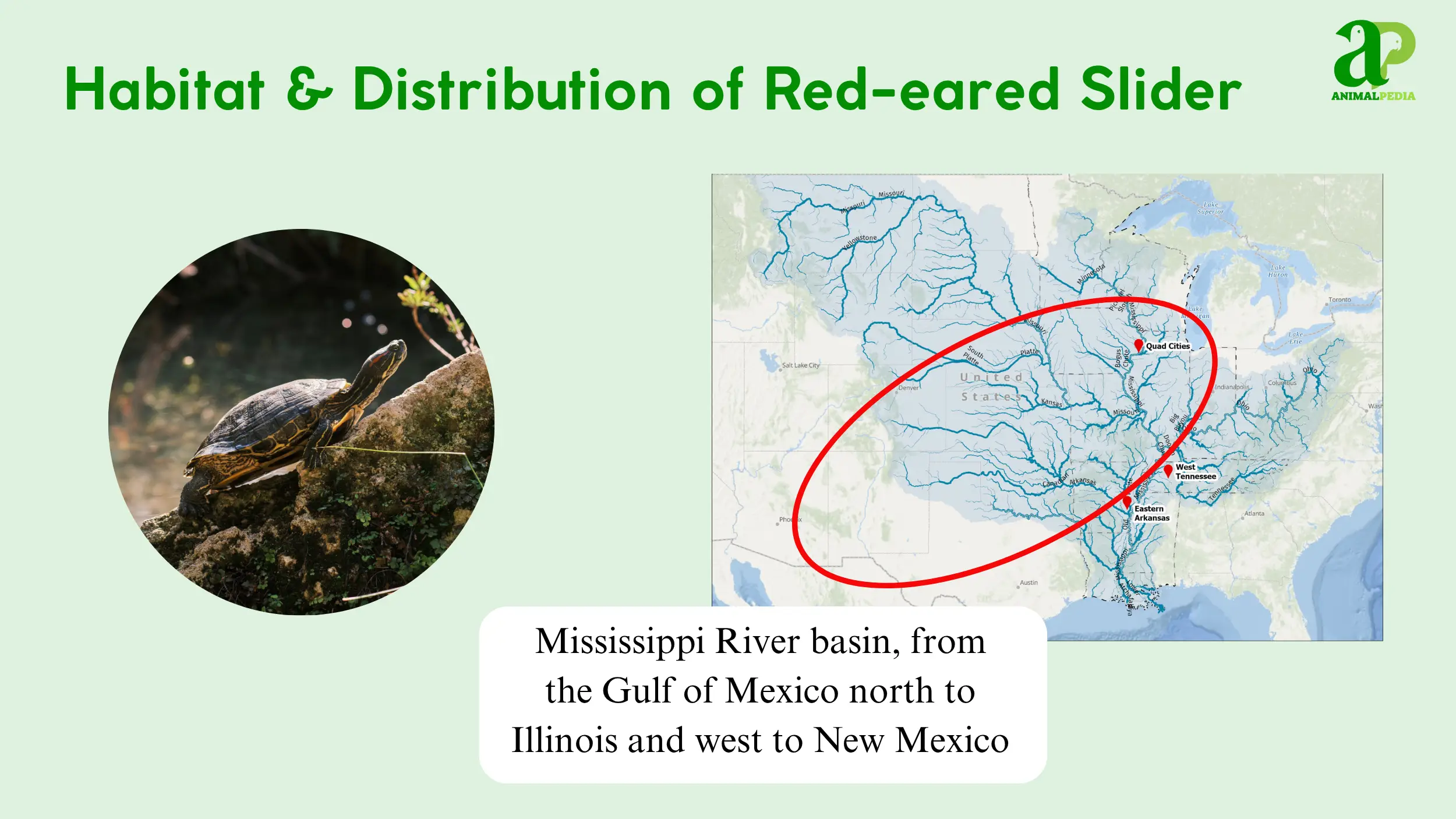
How Do Red-eared Sliders Behave?
The red-eared slider’s behavior is a complex interplay of instinctive foraging, social hierarchy, and physiological adaptations to its environment. These behaviors are essential for their survival in diverse habitats.
- Diet and Feeding: Red-eared sliders, as opportunistic omnivores, consume a varied diet of plant matter and animal prey, with feeding behavior changing from carnivorous to herbivorous with age.
- Movement and Abilities: This species exhibits a combination of terrestrial and aquatic movements, utilizing webbed feet for swimming and powerful limbs for rapid escape on land.
- Daily/Seasonal Patterns: Their daily cycle includes periods of basking for thermoregulation and periods of active foraging, while seasonal brumation allows them to survive the colder months.
Their behaviors, from their selective diets to their physical capabilities and seasonal rhythms, highlight the species’ adaptability to its diverse habitats. The broad range of behaviors displayed by this turtle is central to its survival. A deeper understanding of its feeding habits provides direct evidence of its opportunistic nature.
Diet and Feeding
Red-eared sliders are opportunistic omnivores. While juveniles primarily feed on insects, crustaceans, and aquatic invertebrates, adults shift towards a largely herbivorous diet, consuming aquatic plants and algae [1, 2]. They lack teeth, but strong, horny jaws enable them to crush and tear their food [2]. Their feeding pattern is tied to water temperature, with increased activity in warmer conditions [2].
They use a “sit-and-wait” ambush strategy or actively stalk their prey in the water, consuming smaller items whole [2]. Their feeding habits reveal a great deal about their position in the food web. The ability to acquire food is closely linked to their movement and physical abilities.
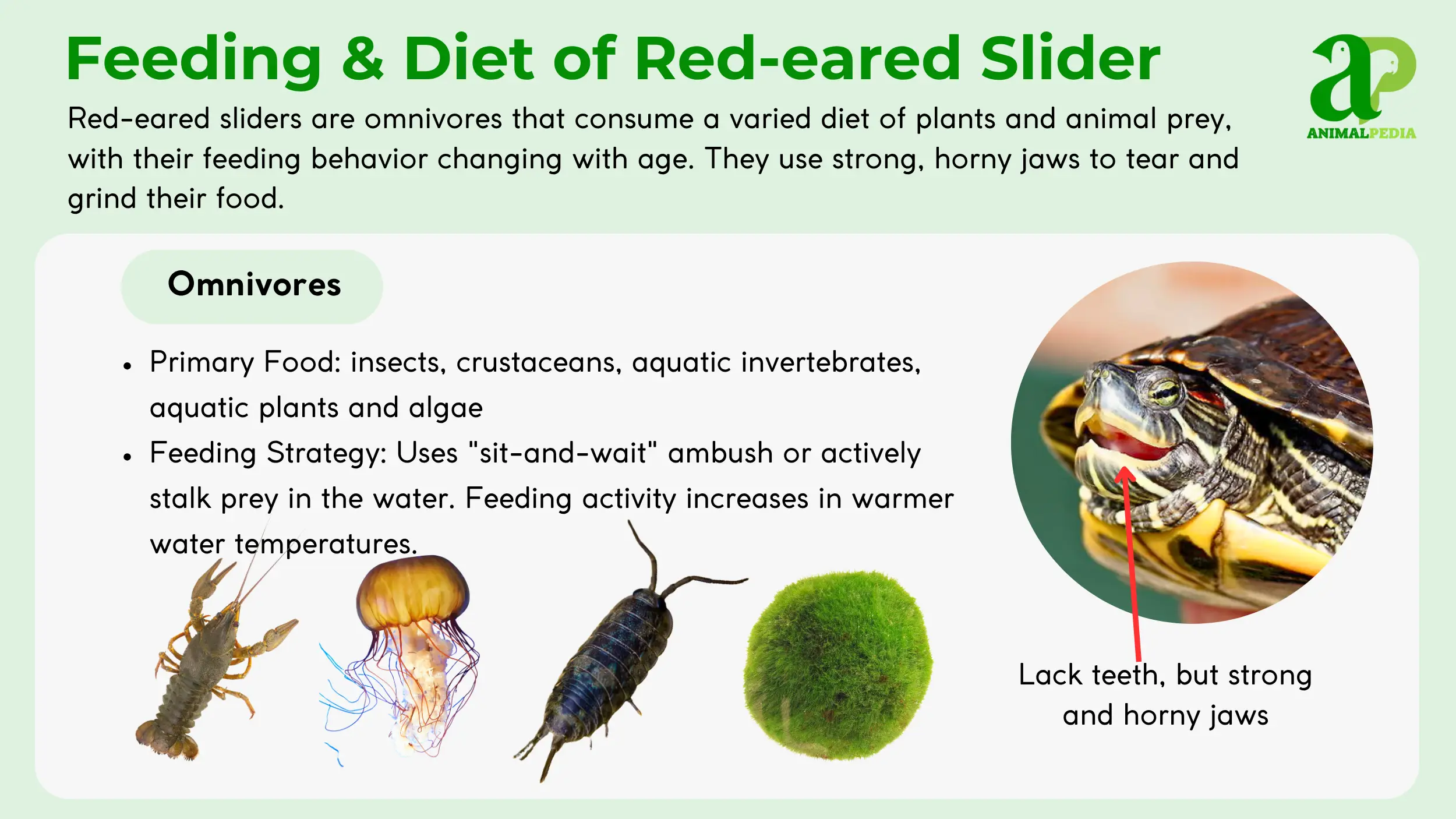
Movement and Abilities
Red-eared sliders exhibit a diverse range of movements, including powerful swimming and terrestrial walking. Their primary mode of aquatic movement involves a coordinated propulsion of their webbed feet, allowing them to glide efficiently through water [2]. On land, they move with a steady, crawling gait, but they are capable of rapid bursts of speed to escape predators [2].
Red-eared Sliders can reach speeds of up to 10 miles per hour (16 km/h) for short distances [12]. Their strong neck and limbs enable them to climb onto rocks and logs for basking, a behavior essential for thermoregulation and Vitamin D synthesis [4]. The movement and agility of the red-eared slider are tied to its daily search for food and warmth. These activities form a larger pattern that changes with the seasons.
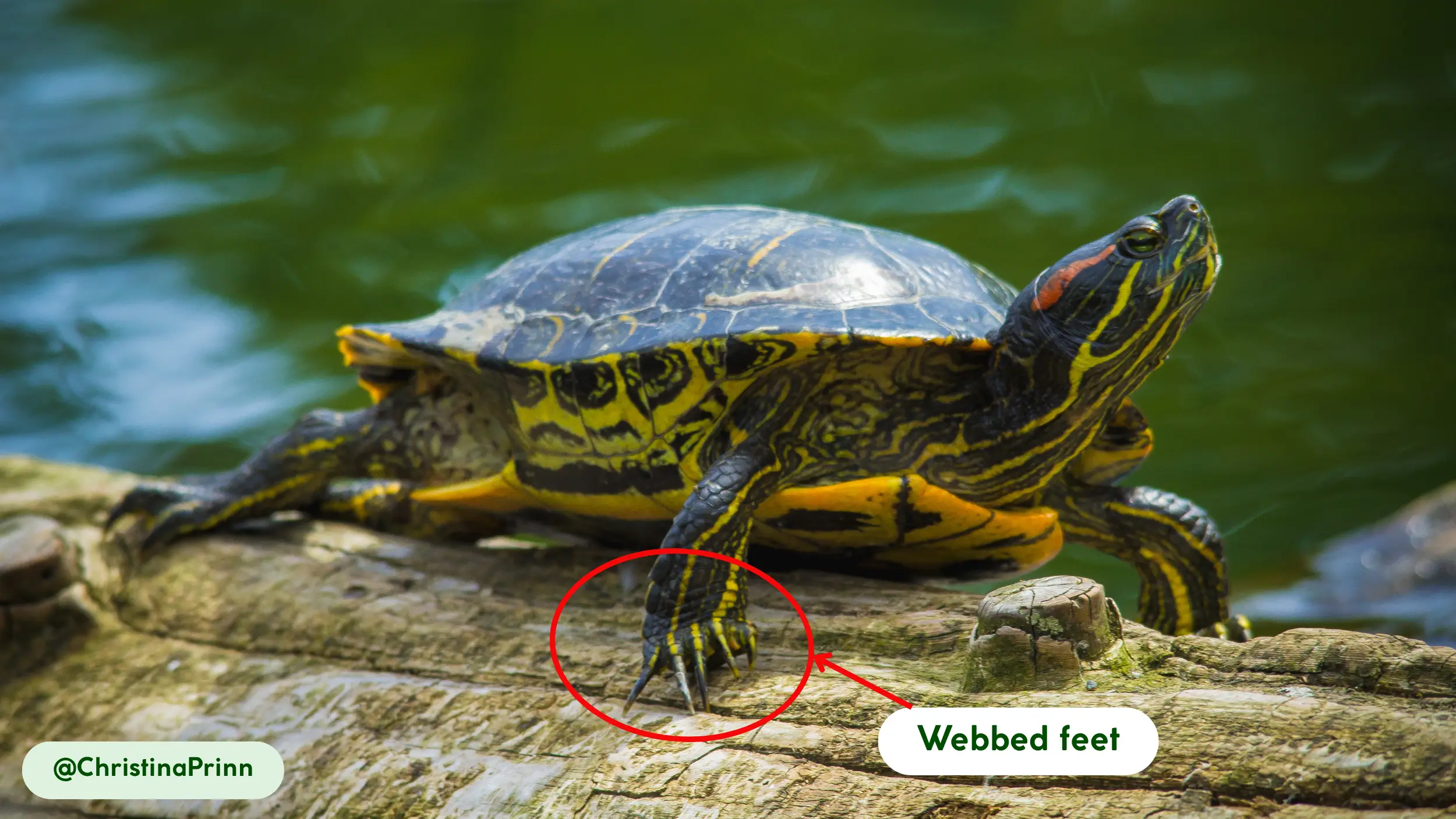
Daily/Seasonal Patterns
The daily activity of red-eared sliders is primarily determined by environmental temperature. They are most active during the day, with peak activity occurring between morning and early afternoon [1]. Their daily cycle revolves around thermoregulation.
A typical day begins with basking on a log or rock to raise their body temperature, followed by foraging and feeding [4]. In the evening, they retreat to the water to sleep on the bottom or near the surface. The species is most active during the warmer months of spring and summer [14].
As temperatures drop in the fall, they seek out deep, muddy bottoms to enter a state of brumation, a period of inactivity similar to hibernation [14]. They do not migrate over long distances but may move between ponds or streams if their habitat dries up [1]. The daily cycle of basking and foraging is part of a larger life history. Reproduction represents the culmination of these behaviors, ensuring the continuation of the species.
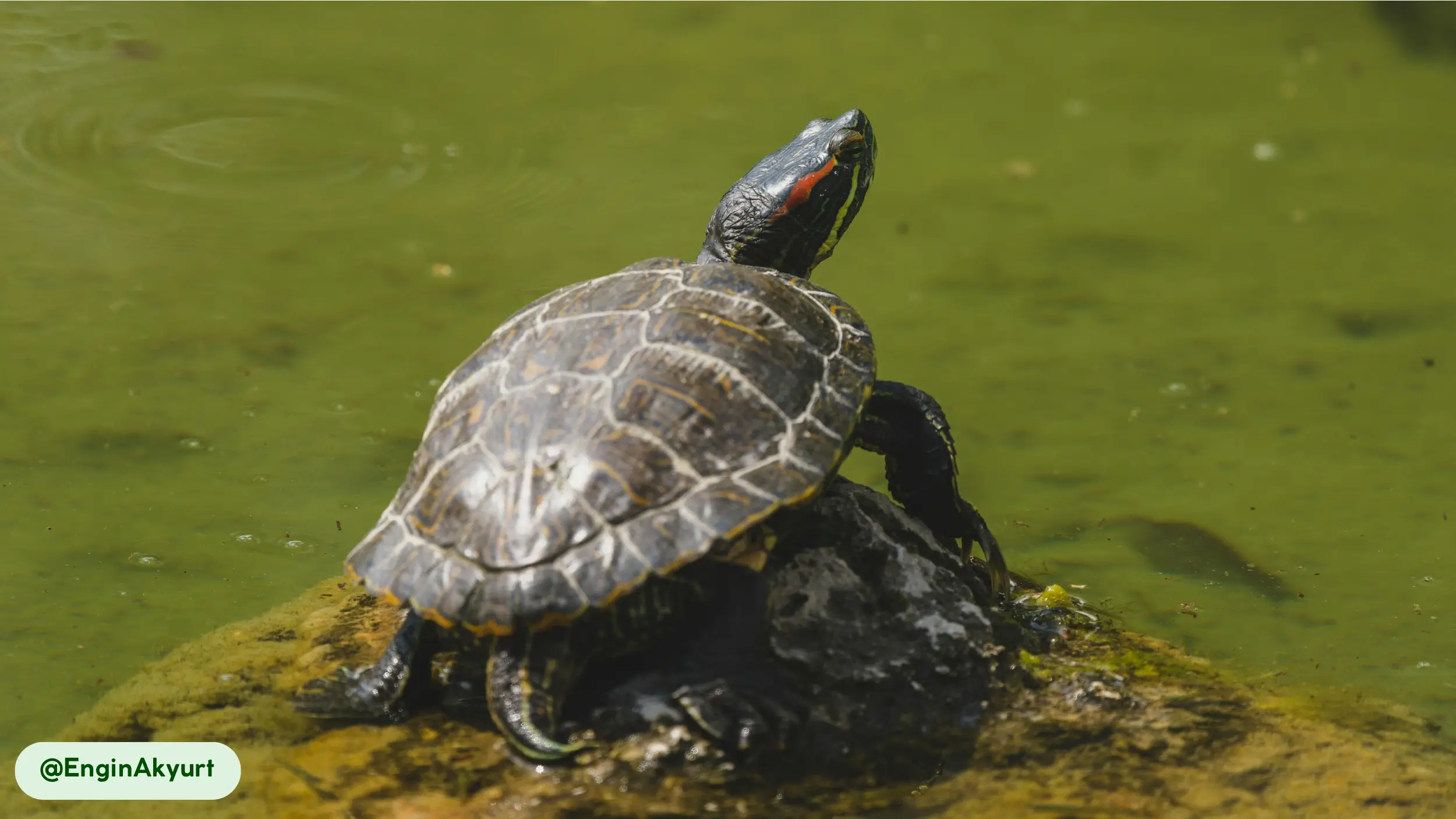
How Do Red-eared Sliders Reproduce?
Red-eared sliders are oviparous, meaning they reproduce by laying eggs. Their mating season typically begins in early spring, triggered by rising water temperatures and longer daylight hours [2]. The male initiates courtship with a specific ritual; he faces the female and uses his elongated foreclaws to vibrate or “tickle” her face [2].
This tactile display serves as a key component of their courtship behavior. After mating, the female travels to a suitable nesting site on land, typically in soft soil or sand, where she deposits a clutch of eggs [10]. A single female can produce multiple clutches in a year, with each clutch containing between 2 to 30 eggs [10].
The incubation period for the eggs lasts approximately 60 to 90 days, with the nest temperature influencing the sex of the hatchlings [10]. Cooler temperatures tend to produce males, while warmer temperatures result in females [10]. After hatching, the young turtles are independent from birth, as there is no parental care [1].
This reproductive strategy allows the species to maintain a resilient population, as documented in studies on turtle reproduction [10]. The success of their reproductive strategy contributes to the species’ overall resilience. This resilience is reflected in their longevity, both in the wild and in captivity.
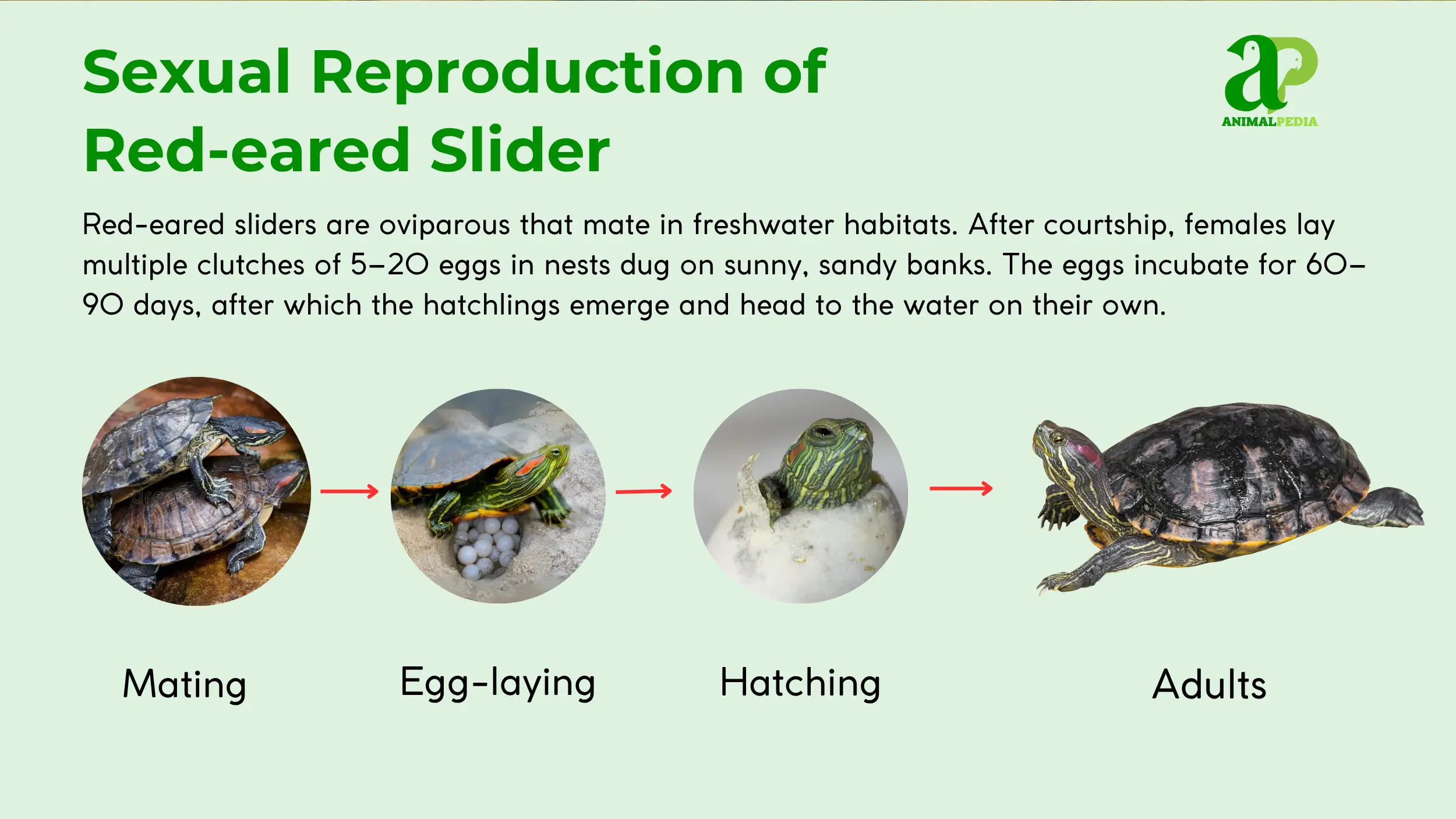
How Long Do Red-eared Sliders Live?
Red-eared sliders can live for a substantial period, particularly in captive environments. In the wild, their lifespan averages around 20 to 30 years, influenced by factors like predation, habitat quality, and disease [1, 11]. In contrast, a well-cared-for red-eared slider in captivity can live up to 50 years or even longer [11, 14]. Longevity in captive turtles is strongly tied to proper nutrition, clean water, and access to a suitable basking area [11].
This Red-eared Slider species reaches sexual maturity relatively early in life; males mature between 2 and 5 years, while females mature slightly later, between 5 and 8 years of age [2]. Their long lifespan allows them to interact with human environments for extended periods. This interaction raises important questions about potential health risks and safety for people.
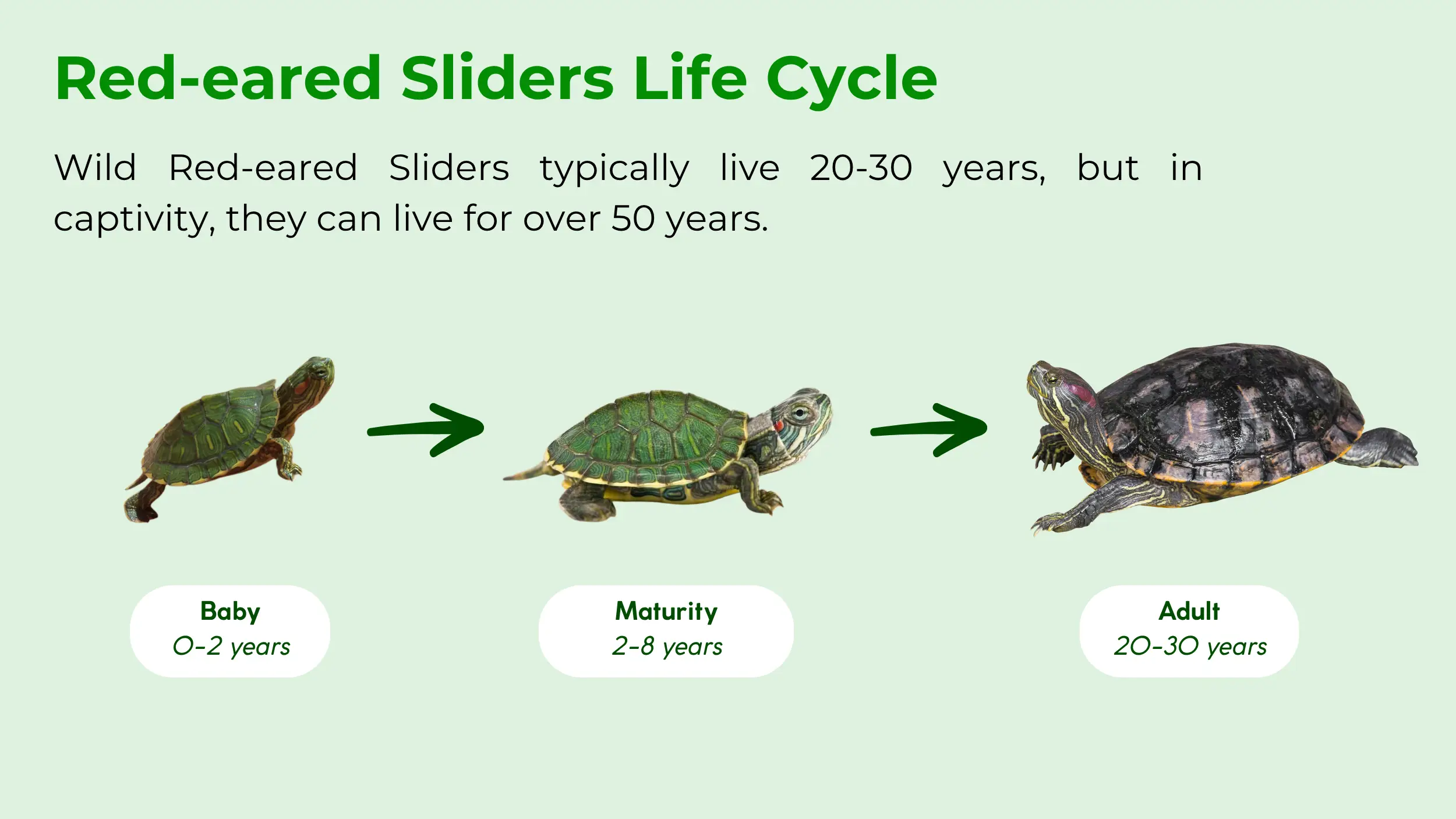
Are Red-eared Sliders Harmful to Humans?
Red-eared sliders are not venomous and do not pose a direct threat of poisoning. However, they can be harmful to humans as they commonly carry Salmonella bacteria, which can cause severe illness [6]. The bacteria can be present on the turtle’s shell and skin and can be transmitted to humans through direct contact with the turtle or its habitat water [6].
While a bite is rare, it can occur as a defensive reaction if the turtle feels threatened, and can cause a painful wound [1]. A turtle’s bite force is not significant enough to cause major injury, but it can break skin, increasing the risk of bacterial infection.
People should always wash their hands thoroughly with soap and water after handling a turtle or anything in its habitat to prevent potential health risks [6]. The conversation around human safety is one aspect of the species’ interaction with people. This turtle’s widespread presence has broader ecological implications, particularly for its conservation status and impact as an invasive species.
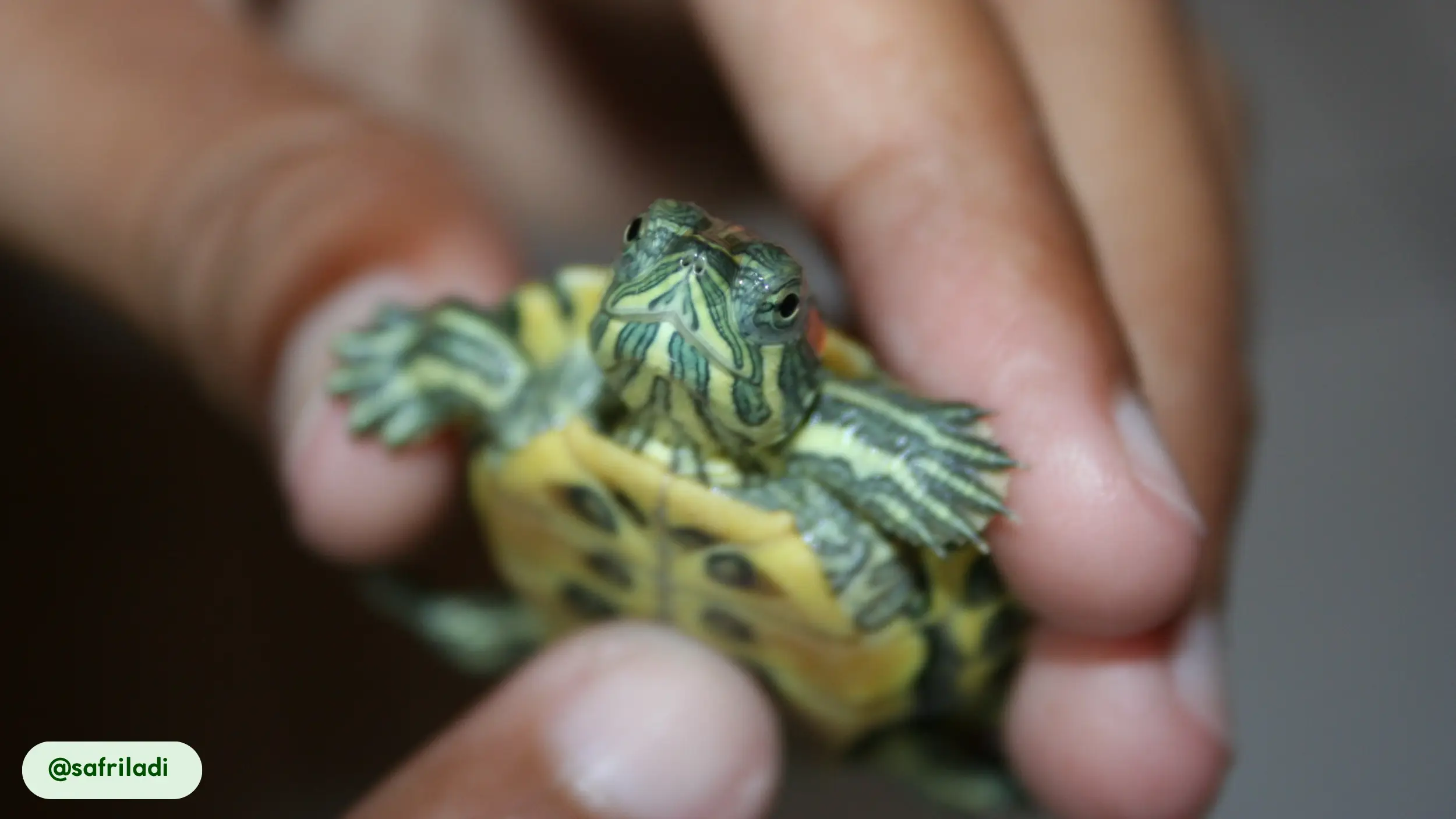
Are Red-eared Sliders Endangered?
The red-eared slider is not an endangered species; in fact, its conservation status is listed as Least Concern on the IUCN Red List [8]. The species is highly adaptable and prolific, enabling it to thrive in a wide range of environments. However, their status as a resilient species creates a separate ecological problem.
The pet trade has led to red-eared sliders becoming one of the world’s most widespread invasive species [7, 19]. They pose a significant threat to native turtle species by competing for food and basking sites, as well as potentially transmitting diseases [9].
Conservation efforts for this species focus on managing invasive populations and educating pet owners about responsible ownership [9, 12]. It is illegal in many regions to release pet turtles into the wild, a key measure to protect native ecosystems. Individuals can support conservation by never releasing a pet turtle and by reporting sightings of invasive populations to local wildlife authorities [12]. The red-eared slider’s conservation status is a testament to its adaptability and success. Their physiological resilience and unique behaviors are the basis for some true facts.
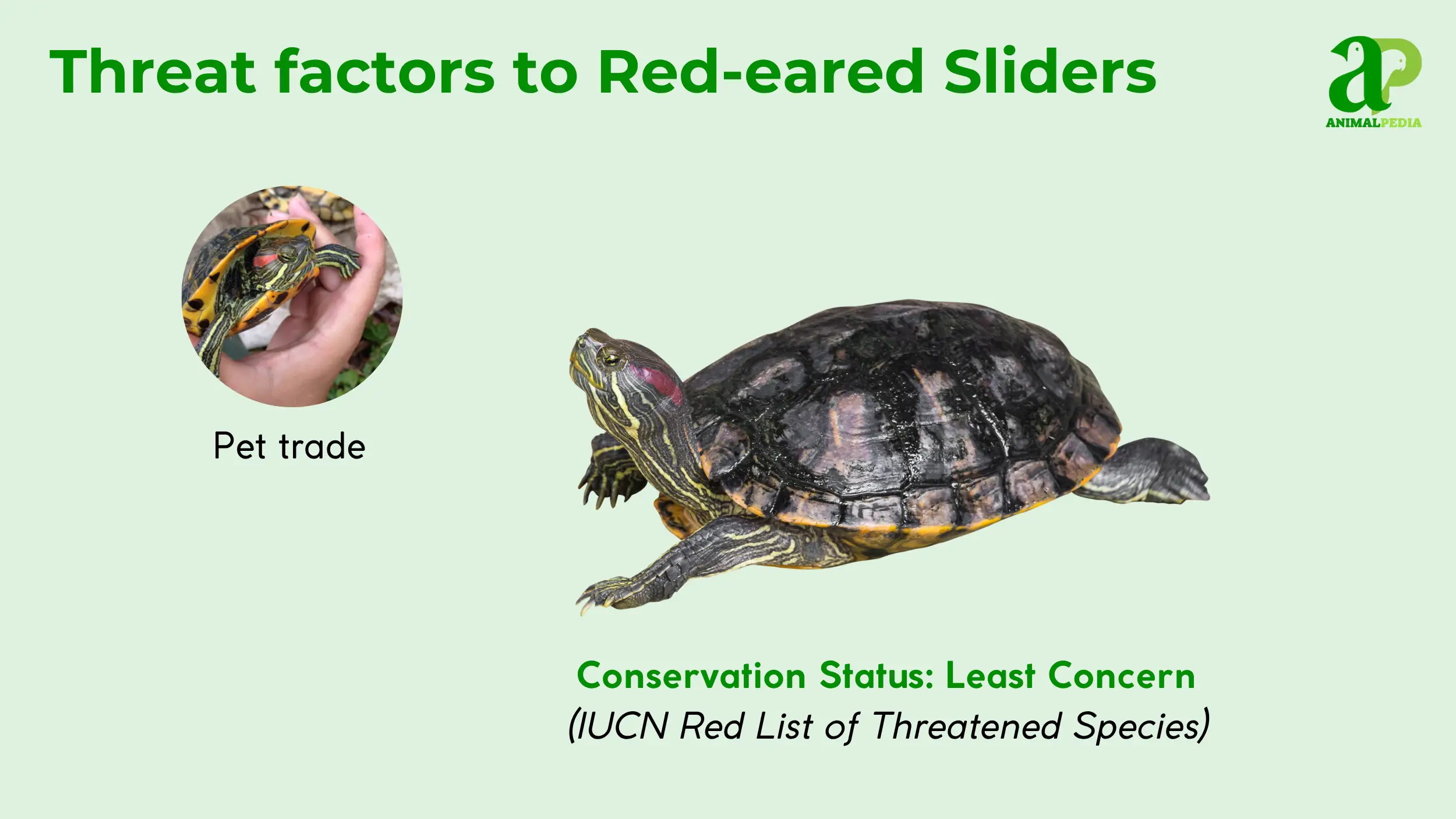
Frequently Asked Questions About Red-eared Sliders
The facts presented here show the depth and complexity of this reptile. This information helps address some of the most frequently asked questions about these turtles.
Are Red-Eared Sliders Good Pets?
Red-eared sliders are not ideal pets for most people. They require specific, large enclosures, specialized lighting, and a commitment to long-term care due to their long lifespan. Additionally, they pose a health risk due to the Salmonella bacteria they often carry [6].
Why Can’t You Keep Red-Eared Sliders?
You can keep red-eared sliders as pets, but there are regulations to consider. It is illegal in the U.S. and many other places to sell or buy turtles with a carapace under 4 inches (10 cm) to prevent the spread of Salmonella to children. Releasing them into the wild is also illegal in many areas [6, 12].
Do Red-Eared Sliders Need To Be In Water All The Time?
No, red-eared sliders are semiaquatic reptiles and require both land and water. They spend time in the water for swimming, feeding, and waste elimination, but they also require a dry basking area on land to raise their body temperature and absorb UV light to synthesize vitamin D [4, 11].
Can Red-Eared Sliders Sleep Out Of Water?
Yes, red-eared sliders are capable of sleeping both in and out of the water. They often sleep at the bottom of a pond, but they can also choose to sleep while basking on their dry platform or in a burrow on land [1].
Do Red-Eared Slider Turtles Bite?
Yes, red-eared sliders can bite, but it is typically a defensive action rather than an aggressive one. A bite can break the skin and may cause a bacterial infection. People should avoid handling them to reduce the risk of biting and to prevent the transmission of Salmonella [1, 6].
Do Red-Eared Sliders Need Light At Night?
No, red-eared sliders do not need light at night. They require a distinct day and night cycle for their biological rhythms. A UVB light and a heat lamp should be used during the day to mimic natural sunlight, but all lights should be turned off at night [16]. A deeper understanding of their needs, from their natural habitats to their nocturnal behavior, provides insight into their care. This knowledge is essential for appreciating the broader ecological role of the red-eared slider.
Conclusion
The red-eared slider is a resilient and widely distributed species, known for its adaptability and significant impact as an invasive organism. Its distinct physical traits and complex behaviors, from its unique mating rituals to its long lifespan, make it a subject of extensive scientific interest. This comprehensive article from Animal Pedia has provided a detailed look into the life of this fascinating reptile. For more in-depth knowledge and to explore other species, continue your journey of discovery through the rest of the Animal Pedia website.

